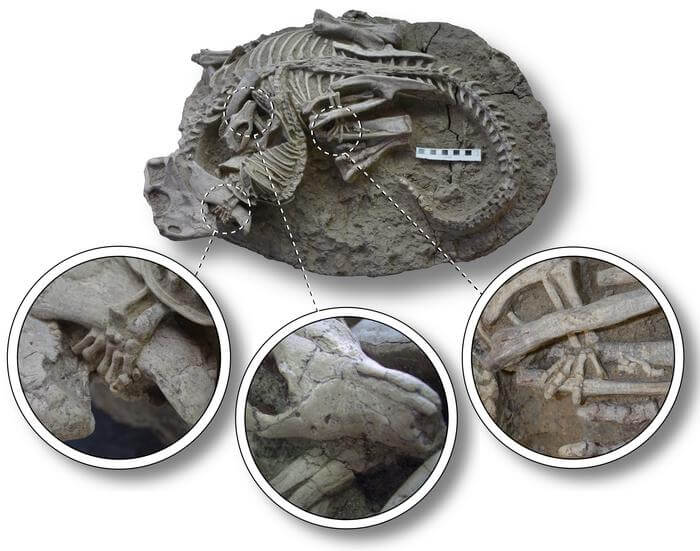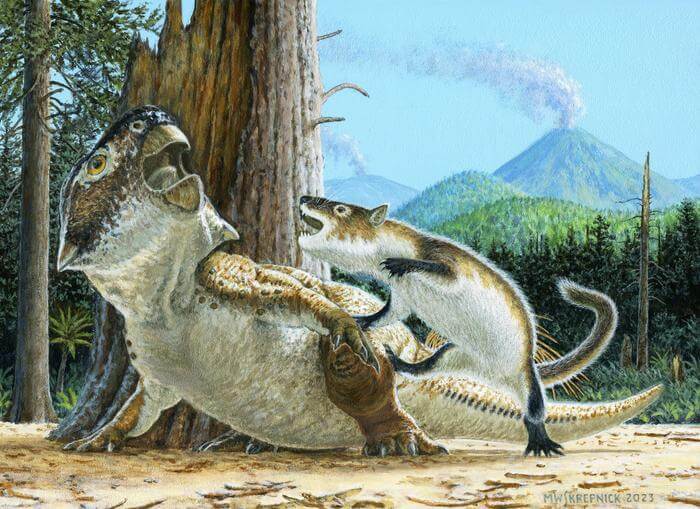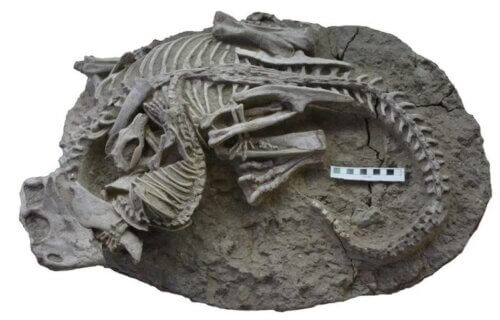OTTAWA, Ontario — An extraordinary fossil showcasing a dinosaur under attack from a mammal has been discovered by paleontologists. The fossil reveals the entwined skeletons of a beaked and horned herbivore, and the smaller, meat-eating mammal Repenomamus. This breathtaking scene was preserved in time when a mudslide buried the two creatures.
“The two animals are locked in mortal combat, intimately intertwined, and it’s among the first evidence to show actual predatory behavior by a mammal on a dinosaur,” explains Dr. Jordan Mallon, paleobiologist with the Canadian Museum of Nature and co-author on the study.
Upon close inspection, it can be seen that the dinosaur lies prone, its hindlimbs folded on either side of its body. The Psittacosaurus, roughly the size of a large dog, is gripped in the jaws of the Repenomamus. The badger-like mammal, known as the largest of the Cretaceous period, coils to the right, positioned atop the dinosaur. The Repenomamus is also seen biting into some of the dinosaur’s ribs while its back foot clings onto the Psittacosaurus’ hind leg.
“The weight of the evidence suggests that an active attack was underway,” says Dr. Mallon in a media release.

The international research team dismissed the possibility of scavenging, as the dinosaur’s bones show no tooth marks. Furthermore, the level of entanglement between the two makes it unlikely. The superior position of the Repenomamus also implies it was the aggressor.
In contemporary times, lone predators such as wolves are known to hunt larger animals, including caribou and domestic sheep. Similarly, on the African savanna, wild dogs, jackals, and hyenas attack live prey, causing them to collapse, often from shock.
“This might be the case of what’s depicted in the fossil, with the Repenomamus actually eating the Psittacosaurus while it was still alive—before both were killed in the roily aftermath,” explains Mallon.

This discovery was made in a prehistoric animal burial site in Liaoning, referred to as ‘China’s Dinosaur Pompeii’. Here, small mammals, lizards, and amphibians were buried abruptly en masse by mudslides and debris following volcanic eruptions.
The findings challenge the notion that dinosaurs had limited threats from their mammalian contemporaries. Both skeletons were found nearly complete.
It was already known that Repenomamus preyed on Psittacosaurus, as fossilized baby bones of the herbivore had been found in the stomach of the mammal.
“The co-existence of these two animals is not new, but what’s new to science through this amazing fossil is the predatory behavior it shows,” Mallon concludes.
The researchers anticipate that the Lujiatun beds will continue to yield new evidence of interactions among species, revealing data otherwise absent from the existing fossil record.
The study is published in the journal Scientific Reports.
South West News Service writer Mark Waghorn contributed to this report.


Such is the way of the world.